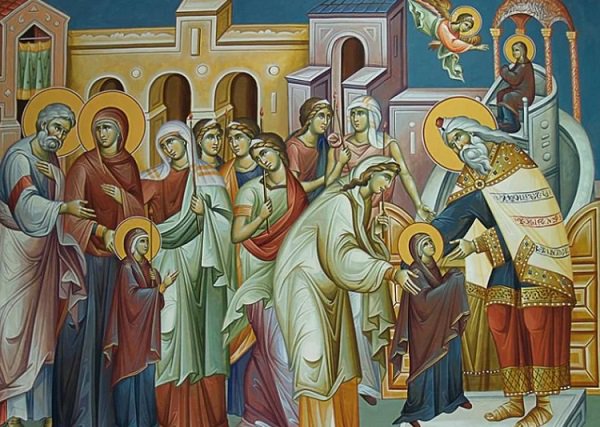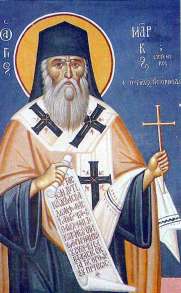Miltiadis Konstantinou, Professor of the School of Theology of the University of Thessaloniki
Our Most Holy Lady as the Temple of God
Were one to attempt to describe in a single sentence the role and aim of the Church, one might say that ‘The aim of the Church is to manifest God to the world’. In order to achieve this aim, the Church uses theology, which expresses the faith of the Church in two ways: either with words or images. But the potential of both words and deeds to make God manifest is necessarily very limited, which is why, if we’re going to understand their content properly, any approach to them needs to be made with great care and with due appreciation of the requirements involved. A typical example of the use of images to express the faith of the Church is the feast we celebrate today, that of the Entry of the Mother of God.
The historical foundation for this feast lies in the time of Byzantium [that is, New Rome]. In Jerusalem, on the site where, in antiquity, the famous temple of Solomon had stood, Emperor Justinian built a great basilica in honour of Our Lady. The inauguration of this church took place on 20 November, 534 and it was commemorated every year on 21 November with great splendour. At the end of the 7th/beginning of the 8th century, this feast became linked with a beautiful Christian legend, according to which, at the age of three, Our Lady was dedicated by her parents to the temple of God, which stood on precisely the same spot where the new church had been built. This is the reason why the Epistle reading for today, to the Hebrews, refers to the description of the temple in Jerusalem.


This link between the temple in Jerusalem and a feast of Our Lady conceals a profound symbolism, and if we are to understand it we must bear in mind the way in which people viewed temples in the pre-Christian era. It was a commonplace of almost all ancient religions that the gods dwelt simultaneously in heaven and in the temples dedicated to them. The temple was the locus where the difference between heaven and earth was lifted, so that anyone entering a temple was, at the same time, standing before the heavenly throne of the god. Within the locus of the temple, the categories of earthly and heavenly were transcended, since the boundaries between the mundane and the celestial became relative. So, in the eyes of the ancients, the temple was a part of the earth which reached up to the heavens or, vice versa, a part of the heavens which reached down to the earth.
Precisely because the locus of the temple was linked to such concepts, the faithful were forbidden entrance. In Jerusalem, only the archpriest was allowed into the inner part, and then only once a year, in order to sprinkle it with the blood of the sacrifice which had been offered in the courtyard. Jesus Christ abolished this strict boundary between the realm inhabited by the divinity and that inhabited by people. God became man and came to dwell among people, and in this way He abolished any division between the divine and the human.
With God’s incarnation, the whole earth then became a temple, where everyone has the opportunity to communicate directly with God. So a Christian church, through its architecture, symbolizes the universe and each part of it represents a portion of the world. The floor indicates the earth, on which we find ourselves. The ceiling symbolizes heaven which is why the Pantokrator is always depicted in the middle, that is, the icon of Christ- Who is usually portrayed as being neither young nor old- in order to indicate the union between the Son and the Father. The architectural part of the church that links the floor with the ceiling, in other words, earth with heaven, is the apse in the sanctuary. This is why, at this particular point, we have the icon of Our Most Holy Lady: to show that, because of the contribution of this poor, little girl from Palestine, the union of earth and heaven became possible. These are icons and symbols which, if read aright, summarize the whole theology of the Church.
The icon of Mary entering the temple represents, in the most vivid manner, her role in the story of the salvation of the human race. Whereas the temple in Jerusalem merely symbolized the locus of God’s habitation, He really did come to dwell in Mary’s womb. Whereas the temple in Jerusalem symbolized God’s heavenly throne, Mary really did become His throne and the hymnographer for today’s feast was right to identify her with the heavens: ‘Heaven and earth rejoice, seeing the spiritual heaven proceeding into the divine abode to be nurtured in holiness’.
And whereas the temple of Jerusalem, as God’s abode, was holy for the Jews, Mary is justly called ‘All-Holy’ by Christians. The icon of her entry into the temple of God announces in the clearest terms the abolition of the boundaries separating the celestial world from the mundane, an abolition achieved by Christ’s sacrifice on the cross and His resurrection. Now everyone has the opportunity to become a citizen of heaven. But this opportunity which God has given us is not free of obligations. Since, as we’ve said, the whole world has become God’s temple, it’s no longer possible to behave in one way in our everyday life and in another at church on Sundays. If you go to church to glorify God, you have to do the same with all your actions in your everyday life.
It’s well-known that the enormous changes at the end of the 20th century on the socio-political and economic levels dashed the hopes of millions of people and gave rise, in many of them, to feelings of insecurity and uncertainty. Thousands have become disillusioned by the various social and economic systems and are seeking solutions and refuge in the most unlikely religions devised by the human brain. Within this general disorientation of the modern era, Christians are called to be witnesses to others, through their way of life. This requires an enduring exercise in self-control, so that all our choices and actions should be in line with the will of God. It also requires a willingness on the part of Christians to listen to what God’s asking of them at every moment of their life, and to be in a position to repeat the words of Mary: ‘Behold your servant, Lord. May what happens to me be in accordance with your word’ (Luke 1, 38). Then the words of the Lord which close the Gospel reading for the feast will be true for them, as well: ‘Blessed are they who hear the word of God and keep it’ (Luke 11, 28).

